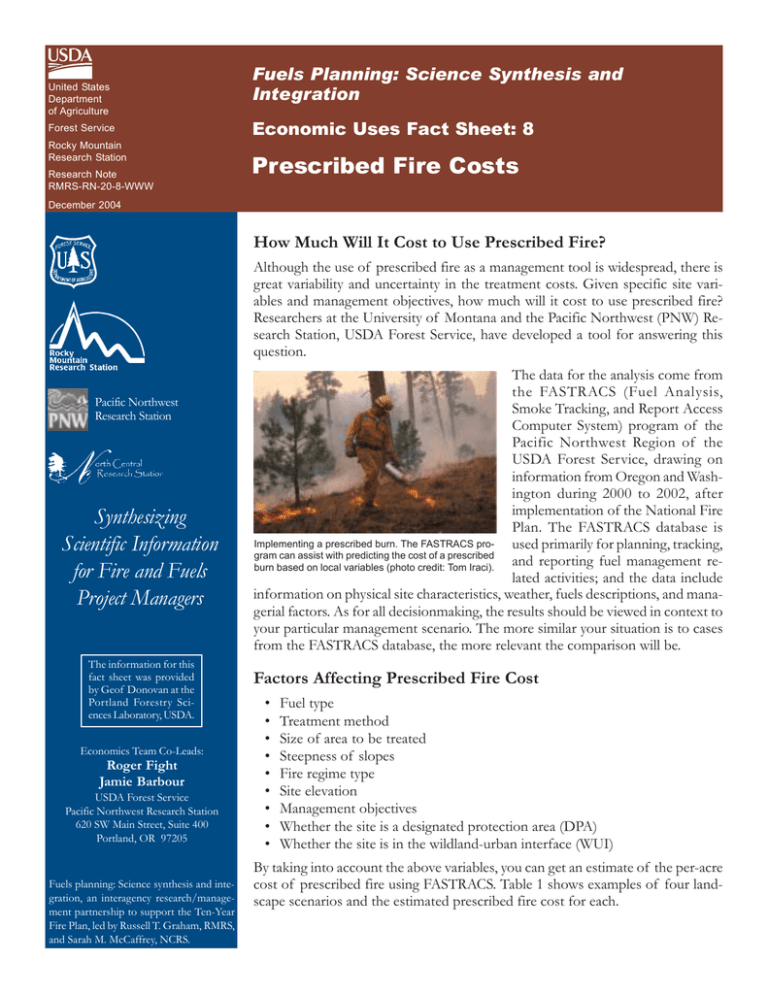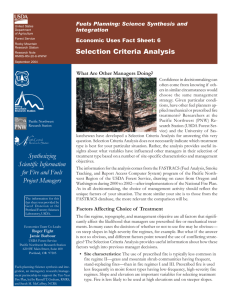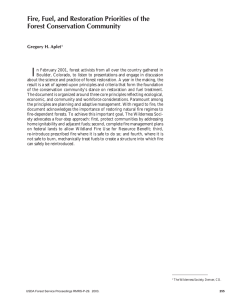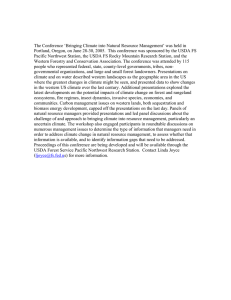Prescribed Fire Costs Fuels Planning: Science Synthesis and Integration
advertisement

United States Department of Agriculture Forest Service Rocky Mountain Research Station Research Note RMRS-RN-20-8-WWW Fuels Planning: Science Synthesis and Integration Economic Uses Fact Sheet: 8 Prescribed Fire Costs December 2004 How Much Will It Cost to Use Prescribed Fire? Although the use of prescribed fire as a management tool is widespread, there is great variability and uncertainty in the treatment costs. Given specific site variables and management objectives, how much will it cost to use prescribed fire? Researchers at the University of Montana and the Pacific Northwest (PNW) Research Station, USDA Forest Service, have developed a tool for answering this question. Pacific Northwest Research Station Synthesizing Scientific Information for Fire and Fuels Project Managers The information for this fact sheet was provided by Geof Donovan at the Portland Forestry Sciences Laboratory, USDA. Economics Team Co-Leads: Roger Fight Jamie Barbour USDA Forest Service Pacific Northwest Research Station 620 SW Main Street, Suite 400 Portland, OR 97205 Fuels planning: Science synthesis and integration, an interagency research/management partnership to support the Ten-Year Fire Plan, led by Russell T. Graham, RMRS, and Sarah M. McCaffrey, NCRS. The data for the analysis come from the FASTRACS (Fuel Analysis, Smoke Tracking, and Report Access Computer System) program of the Pacific Northwest Region of the USDA Forest Service, drawing on information from Oregon and Washington during 2000 to 2002, after implementation of the National Fire Plan. The FASTRACS database is Implementing a prescribed burn. The FASTRACS proused primarily for planning, tracking, gram can assist with predicting the cost of a prescribed and reporting fuel management reburn based on local variables (photo credit: Tom Iraci). lated activities; and the data include information on physical site characteristics, weather, fuels descriptions, and managerial factors. As for all decisionmaking, the results should be viewed in context to your particular management scenario. The more similar your situation is to cases from the FASTRACS database, the more relevant the comparison will be. Factors Affecting Prescribed Fire Cost • • • • • • • • • Fuel type Treatment method Size of area to be treated Steepness of slopes Fire regime type Site elevation Management objectives Whether the site is a designated protection area (DPA) Whether the site is in the wildland-urban interface (WUI) By taking into account the above variables, you can get an estimate of the per-acre cost of prescribed fire using FASTRACS. Table 1 shows examples of four landscape scenarios and the estimated prescribed fire cost for each. Table 1—Four examples of prescribed fire cost estimates. Variables Estimated cost per acre 500-acre area, brush/grass 1,000 feet elevation 5 percent slope No WUI Ecosystem restoration Underburn Natural fuels $31 2,000-acre area, ponderosa pine 2,500 feet elevation 25 percent slope WUI Forest health Underburn Natural fuels $86 200-acre area, mixed conifer 3,000 feet elevation 15 percent slope DPA No WUI Fuel reduction Broadcast burn Whole tree removal 100-acre area, Douglas-fir 4,000 feet elevation 10 percent slope No WUI Fuel reduction Burn machine piles Max log 4x4 The PNW Research Station has developed an interactive, computer-based calculator that can help with estimating the costs of these and other types of fuel treatments. The calculator, called My Fuel Treatment Planner (MyFTP), is the basis for fact sheet RMRS RN-204WWW. References $174 Cleaves, D. A.; Brodie, J. D. 1990. Economic analysis of prescribed burning. In: Walstad, J. D.; [and others], eds. Natural and prescribed fire in Pacific Northwest forests. Corvallis, OR: Oregon State University Press: 271–282. Cleaves, D. A.; Haines, T. K.; Martinez, J. 1999. Prescribed burning costs: trends and influences in the National Forest System. In: Proceedings of the symposium on fire economics, planning and policy: bottom lines. Gen. Tech. Rep. PSW-GTR-173. Albany, CA: U.S. Department of Agriculture, Forest Service, Pacific Southwest Research Station: 227. Rideout, D. B.; Omi, P. N. 1995. Estimating the cost of fuels treatment. Forest Science. 41(4): 664–674. $12 U.S. Department of Agriculture and U.S. Department of the Interior. 1995. Federal wildland fire management policy and program review report. Washington, DC: U.S. Department of the Interior, U.S. Department of Agriculture. 41p. Economics Team Fact Sheets Fuels Planning: Synthesis and Integration Look for fact sheet topics from the Economics Team including prescribed fire costs, harvesting, log hauling, NEPA and other regulations, wood utilization, economic impacts on communities, markets for wood, and harvest equipment requirements. This fact sheet is one in a series being produced as part of a larger project supported by the USDA Forest Service to synthesize new knowledge and information relevant to fire and fuels management. Fact sheets address topics related to stand structure, environmental impacts, economics, and human responses to these factors. Information in the fact sheets is targeted for the dry forests of the Inland West, but is often applicable across broad regions of the country. For more information, please visit our Web site at: www.fs.fed.us/fire/tech_transfer/synthesis/synthesis_index The Fuels Planning fact sheets are based on preliminary findings. Information from fact sheets will be synthesized in an upcoming publication.




